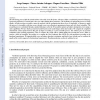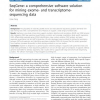804 search results - page 4 / 161 » Solutions to Computational Problems Through Gene Assembly |
CORR
2010
Springer
13 years 7 months ago
2010
Springer
The tolerancing process links the virtual and the real worlds. From the former, tolerances define a variational geometrical language (geometric parameters). From the latter, there...
BMCBI
2011
12 years 11 months ago
2011
Background: The popularity of massively parallel exome and transcriptome sequencing projects demands new data mining tools with a comprehensive set of features to support a wide r...
CORR
2007
Springer
13 years 7 months ago
2007
Springer
Assembling a gene from candidate exons is an important problem in computational biology. Among the most successful approaches to this problem is spliced alignment, proposed by Gelf...
TCS
2008
13 years 7 months ago
2008
Formalized study of self-assembly has led to the definition of the tile assembly model, a highly distributed parallel model of computation that may be implemented using molecules ...
RECOMB
2001
Springer
14 years 8 months ago
2001
Springer
For the last twenty years fragment assembly in DNA sequencing followed the "overlap - layout - consensus" paradigm that is used in all currently available assembly tools...


